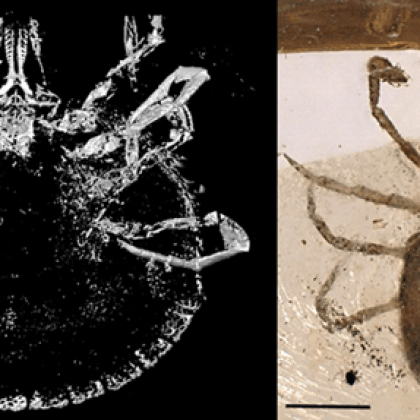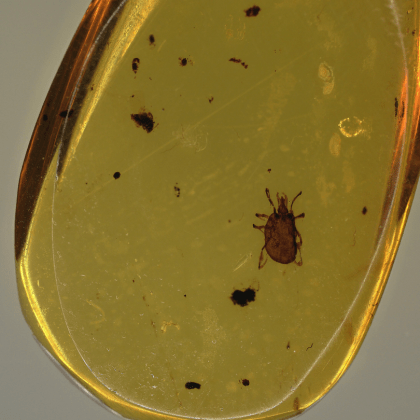Amblyomma birmitum a new species of hard tick in Burmese amber
The latest Parasitology Paper of the Month is “Amblyomma birmitum a new species of hard tick in Burmese amber” by Lidia Chitimia-Dobler, Bruno Cancian de Araujo, Bernhard Ruthensteiner, Timo Pfeffer, Jason A. Dunlop.
This project began as a fortuitous telephone call from a colleague who collects and studies spiders in amber to say he had a tick in amber too, and would I be interested in working on it. It was clear from the outset that this could be an important find, as fossil ticks are very rare with only a handful of examples world-wide. This new specimen also comes from Burmese amber which is found in Myanmar. At nearly 100 million years old (the mid-Cretaceous) it would make it one of the oldest ticks ever found and part of the arthropod fauna that crawled under the feet of the dinosaurs. An amber record from Southeast Asia might also have something interesting to say about biogeography.
My experience is with fossils of arachnids in general, so I put together a team with an expert for modern ticks (our lead author Lidia Chitimia-Dobler) and other colleagues experienced in imaging fossils. We could show that our new amber tick belongs to a living genus, Amblyomma, and we described it as a new species. Ticks can be broadly divided into hard and soft ticks and this is one of the oldest hard ticks and, significantly, dates from a time not long after the molecular biologists predicted that this genus should have split from its closest relatives. Several ticks in the genus Amblyomma feed on reptiles today, but other species use birds or mammals. This raises interesting questions about what the fossil tick was feeding on.
Another important aspect of the project was the realization that most Amblyomma ticks today are found in the southern hemisphere: the continents which made up the former supercontinent of Gondwana. The new fossil comes from a site in the Northern Hemisphere (Myanmar) and there are several models of biogeography that we have to consider to understand where Amblyomma ticks originated, and how they got into Burmese amber and later achieved their modern patterns of distribution. One idea is that animals like these ticks were once widely distributed across all continents, but at some point became partially or entirely restricted to the southern hemisphere. This is known as the ‘ousted relicts’ hypothesis.
For the future, the description of another tick in Burmese amber from a different living genus is currently underway, and several collectors have contacted us with offers of further specimens. Our hope is to study these fossils further to build up a better picture of when the modern tick genera evolved and to get a feel for which ectoparasites which were active by the mid-Cretaceous, and who their potential hosts might have been. Other arthropods (fleas, lice, certain bugs, etc.) feed on blood as well, and we hope that in a wider context our work will contribute to better understanding of when parasitic relationships between arthropods and vertebrates first became established and how this relates to estimates of when diseases transmitted by these parasites first evolved.
Read the full article “Amblyomma birmitum a new species of hard tick in Burmese amber” in full for free until 31st August 2017.





